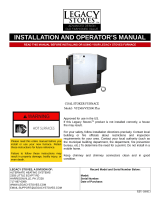Page is loading ...

www.eldcontrols.com
Please retain these instructions after installation.
This device MUST be installed by a qualied agency in accordance with the manufacturer's installation instructions. The denition of
a qualied agency is: any individual, rm, corporation or company which either in person or through a representative is engaged
in, and is responsible for, the installation and operation of HVAC appliances, who is experienced in such work, familiar with all the
precautions required, and has complied with all the requirements of the authority having jurisdiction.
READ THESE INSTRUCTIONS CAREFULLY AND COMPLETELY BEFORE PROCEEDING WITH THE INSTALLATION.
Installation Date:
Installed By: Phone:
BAROMETRIC DRAFT CONTROLS
MODEL: FIELD R-C

page 2
CHOOSING THE LOCATION
Do not attach draft control to top or bottom of the ue pipe, nor in room separated from appliance. Best
location is as close to appliances as possible.
INSTALLATION
Important: Make these adjustments when installing.
Vertical Flue: (1) Adjustment weight must be in
RIGHT HAND SLOT (Marked "V") in bracket on
gate. (2) The arrow on ap at bottom of gate must
line up with letter "V" on lower right part of gate. If
it does not, remove ap, turn over and snap on to
gate again.
Flap can be removed by inserting small screw
driver at the back side of the gate between the gate
and the ap, then pulling downward on ap.
Horizontal Flue: (1) Adjustment weight must be in
LEFT HAND SLOT (Marked "H") in bracket on gate.
(2) The arrow on ap at bottom of gate must line up
with letter "H" on lower left part of gate. If it does
not, remove ap, turn over and snap on to gate
again.
Bend outward the two ears at the front corners of
collar and insert clamping screw. Bolt the remainder
of the collar together. (See Figure 2)
Hold the collar against the ue in the EXACT
position and mark the outline of the collar on the
ue. Cut a hole in the ue about half an inch smaller
than the marks.
Figure 1
Figure 2
Figure 3

page 3
Then cut a series of short slits (about
3
⁄8" or
1
⁄2" deep) around the edges of the opening. After the collar is
strapped on the ue the cut edges can be bent outward in the collar and thus make a better joint. WHEN
FINISHED, THE OPENING INTO THE FLUE MUST BE FULL SIZE OF THE COLLAR OF THE DRAFT CONTROL.
If ue pipe is made of material too heavy to bend out into collar, the opening into the ue must be within
1
⁄4"
of the same diameter as the collar.
Strap the collar to the ue pipe and place the draft control into the collar, fastening it there by tightening the
clamping screw in the collar.
Use a spirit level to make sure that the control does not lean forward or backward but instead is plumb in
both directions, regardless of whether the ue is horizontal, vertical, or sloping.
ADJUSTING THE CONTROL
Set the control to maintain as low a draft as will give good combustion and meet the requirements for heat.
Turn adjustment weight counter-clockwise to loosen, then slide in slot to proper position and tighten. Bracket
is marked 2, 4, 6 and 8, which indicates draft settings of .02", .04", etc. (These are drafts in ue adjacent to
control, not over-re drafts).
OIL BURNERS
The burner must be running when the adjustment of the control is made. Take draft readings over the re.
For a domestic oil burner the overre draft should be approximately .02" to .03", although there are some
makes of burners which require higher drafts. Consult with the burner manufacturer. There must always be
enough draft so that the burner does not pu back into the room at the moment it starts, and there should be
no objectionable smoke. It is essential that CO
2
readings be taken to determine the proper adjustments.
GAS-FIRED PLANTS
Domestic gas-red furnaces or boilers usually operate on very low overre drafts which mean almost zero
drafts at the smoke outlets.
Draft controls having double swinging gates, known as Type G and MG regulators, are available. The gates
of such controls open inward under normal up-draft conditions, and outward in case of blocked ues, thus
relieving internal pressures.
STOKERS
Adjustments must be made while the stoker is running, with a normal fuel bed depth and its fan adjusted to
approximately the correct setting.
When a draft gauge is available, draft reading should be taken over the re. For a domestic stoker, the draft
should be set at .04" OVER THE FIRE, with the STOKER ON. Have just enough draft so that at the moment
the stoker starts, it does not gas or pu back into the room through cracks around the re door (with the re
door closed). If there is objectionable smoke, increase draft slightly.
HAND-FIRED PLANTS
Adjust the draft control when a good re is burning. Close any check damper and open wide any internal
damper.
Usually a draft of .06" will be sucient for cold weather, with reasonably quick pick up after a banked
period. But if plant overheats, change to a lower draft setting. Raise the setting if there is not enough heat.
In mild weather when less heat is needed, or the re is to be banked, close ash pit draft door partly or
entirely. If desired, a check damper also can be used when banking the re.

Phone: 252.522.3031 • Fax: 252.522.0214
www.fieldcontrols.com
© Field Controls, LLC P/N DC01575700 Rev B 04/15
WARRANTY
For warranty about this or any Field Controls product, visit:
www.eldcontrols.com/warranty
/



